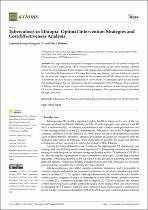| dc.contributor.author | Mengistu, Ashenafi Kelemu | |
| dc.contributor.author | Witbooi, Peter J. | |
| dc.date.accessioned | 2022-08-22T12:28:04Z | |
| dc.date.available | 2022-08-22T12:28:04Z | |
| dc.date.issued | 2022 | |
| dc.identifier.citation | Mengistu, A. K., & Witbooi, P. J. (2022). Tuberculosis in Ethiopia: Optimal intervention strategies and cost-effectiveness analysis. Axioms, 11(7), 343. https://doi.org/10.3390/axioms11070343 | en_US |
| dc.identifier.issn | 2075-1680 | |
| dc.identifier.uri | https://doi.org/10.3390/axioms11070343 | |
| dc.identifier.uri | http://hdl.handle.net/10566/7758 | |
| dc.description.abstract | This paper searches for optimal strategies for the minimization of the number of high-risk
latent and active tuberculosis (TB) infectious individuals using real data from Ethiopia. Optimal
control theory is harnessed for investigation and analysis of the optimal combination of interventions
for controlling the transmission of TB using distancing, case finding, and case holding as controls.
We calculate and compare the incremental cost-effectiveness ratio (ICER) for each of the strategies
to determine the most effective combination of interventions for curbing the spread of the disease.
Our findings suggest that, for optimal cost-effective management of the TB disease, the government
of Ethiopia must focus more on prevention strategies such as isolation of infectious people, early
TB patient detection, treatment, and educational programs. The optimal strategy is quantified
through simulation. | en_US |
| dc.language.iso | en | en_US |
| dc.publisher | MDPI | en_US |
| dc.subject | Tuberculosis | en_US |
| dc.subject | Social distancing | en_US |
| dc.subject | Isolation | en_US |
| dc.subject | PU | en_US |
| dc.subject | South Africa | en_US |
| dc.title | Tuberculosis in Ethiopia: Optimal intervention strategies and cost-effectiveness analysis | en_US |
| dc.type | Article | en_US |

